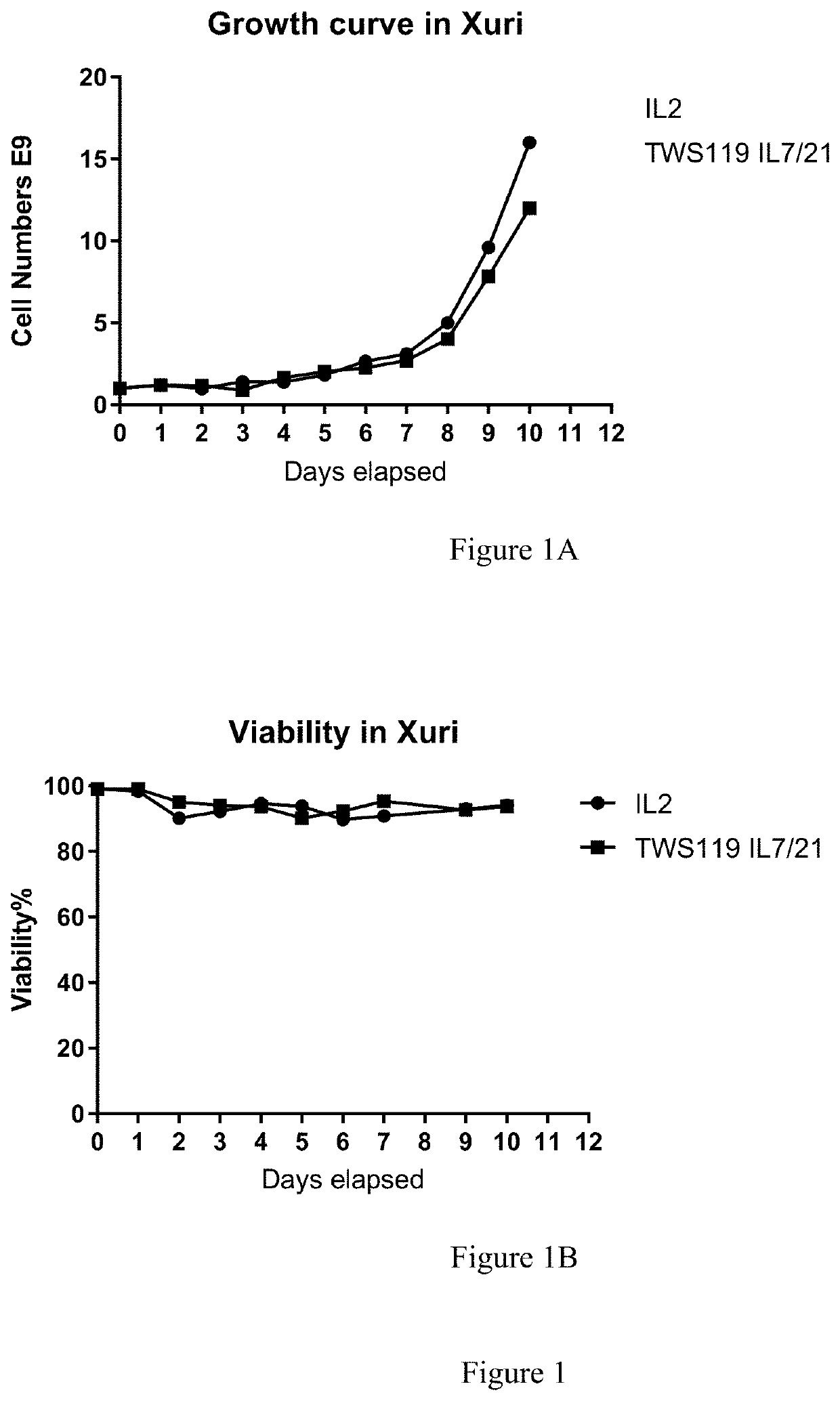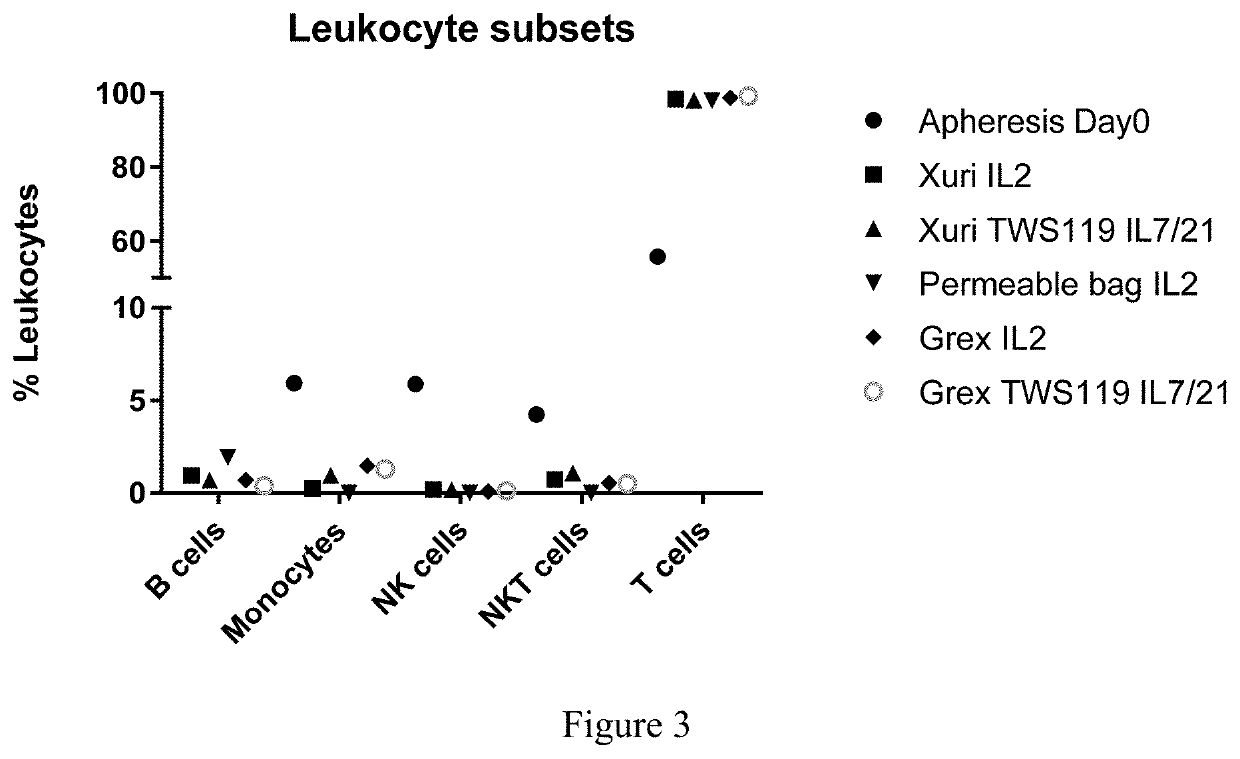Process for generating genetically engineered autologous t cells
- Summary
- Abstract
- Description
- Claims
- Application Information
AI Technical Summary
Benefits of technology
Problems solved by technology
Method used
Image
Examples
example 2
Addition of a Glycolysis Inhibitor to the Culture Media
[0165]On day 0, a fresh Leukopack (Hemacare, Northridge, Calif.), containing 300 ml fresh leukapheresis product collected from normal peripheral blood was sterile welded to a CD-600.1 Sepax Cell Separation Kit (GE Healthcare) and processed under Culture Wash-Pro program. The Leukopack® comprised leukocytes, erythrocytes, and platelets. The cells were washed in 1 L ClinMACS PBS / EDTA, 5 ml human serum albumin (Miltenyi Biotec) to remove plasma and apheresis buffers using a Sempax CPro Cell Separation System equipped with a CS-600.1 Kit (GE Healthcare), according to manufacturer's instructions. The cells were washed and counted as described above in Example 1.
[0166]A portion of the washed apheresed donor cells comprising 1.2E9 nucleated cells were transferred into two transfer bags under the Dilute program using Sepax C-Pro processing system with the same CS-600.1 Kit (a new kit was not used). Into one bag was added about 8 ml of M...
example 3
[0185]This experiment compared CAR and TCR transduction of cells from an apheresed cell sample from a donor (Unenriched) with cells from the same apheresed cell sample that was further enriched for T cells (Enriched).
[0186]On day 0, a fresh Leukopack (Hemacare, Northridge, Calif.), containing 300 ml fresh enriched leukapheresis product collected from normal peripheral blood was sterile welded to a CD-600.1 Sepax Cell Separation Kit (GE) and processed under the Culture Wash-Pro program. The Leukopack® contained leukocytes, erythrocytes, and platelets. The cells were washed to remove plasma and apheresis buffers as described above in Example 1 and the nucleated cells were counted using NC-200™ Automated Cell Counter and split equally into two transfer bags (Sample 1, Enriched T cells) and (Sample 2, Unenriched apheresed donor cells) using the Sepax C-Pro cell processing system Dilute program.
[0187]For Sample 1, “Enriched T cells”, the T cells were isolated from the washed apheresed ce...
example 4
this Example Provides a Closed Continuous Method for Producing Genetically Engineered Autologous T Cells that Express a T Cell Receptor
[0201]On day 0, a fresh Leukopack (Hemacare, Northridge, Calif.), containing 300 ml fresh enriched leukapheresis product collected from normal peripheral blood was sterile welded to a CD-600.1 Sepax Cell Separation Kit (GE) and processed under Culture Wash-Pro program. The Leukopack contained leukocytes, erythrocytes, and platelets. The cells were washed in 1 L ClinMACS PBS / EDTA, 5 ml human serum albumin (Miltenyi Biotec, San Diego, Calif.) to remove plasma and apheresis buffers using a Sepax CPro equipped with a CS-600.1 Kit (GE Healthcare) according to manufacturer's instructions. Based on the initial white blood cell (WBC) count indicated on the donor information sheet accompanying the Leukopack®, the cells were eluted at a cell density of 150E6 WBC / ml with ˜50 ml OpTimizer complete media.
[0202]The nucleated cells in the washed leukapheresed harve...
PUM
| Property | Measurement | Unit |
|---|---|---|
| Temperature | aaaaa | aaaaa |
| Fraction | aaaaa | aaaaa |
| Time | aaaaa | aaaaa |
Abstract
Description
Claims
Application Information
 Login to View More
Login to View More - R&D
- Intellectual Property
- Life Sciences
- Materials
- Tech Scout
- Unparalleled Data Quality
- Higher Quality Content
- 60% Fewer Hallucinations
Browse by: Latest US Patents, China's latest patents, Technical Efficacy Thesaurus, Application Domain, Technology Topic, Popular Technical Reports.
© 2025 PatSnap. All rights reserved.Legal|Privacy policy|Modern Slavery Act Transparency Statement|Sitemap|About US| Contact US: help@patsnap.com



